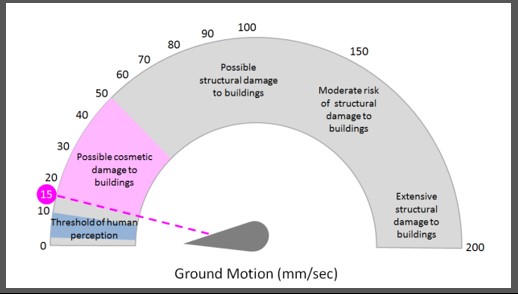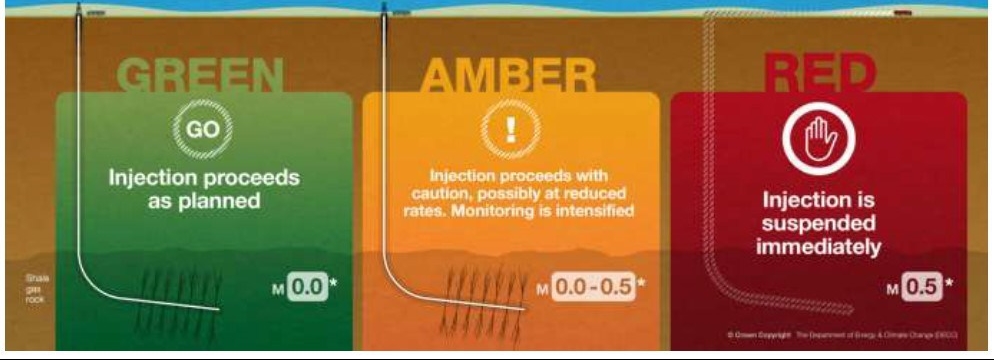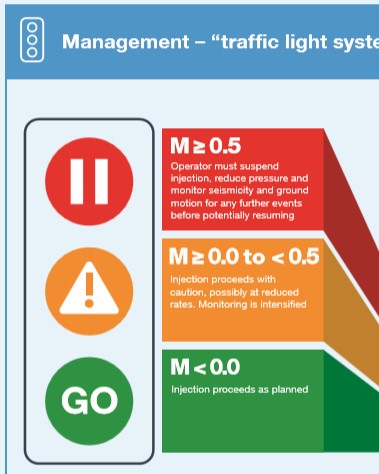 Fracking at Cuadrilla’s shale gas site near Blackpool, which began last week, has already been linked to 12 minor earth tremors.
Fracking at Cuadrilla’s shale gas site near Blackpool, which began last week, has already been linked to 12 minor earth tremors.
They were too small to feel at the surface. Some were described as micro-seismic events.
But two, with magnitudes of 0.3 and 0.4, reached the amber level on the traffic light system, the regulation for monitoring earthquakes induced by fracking.
Another of this week’s tremors, at 0.48, was almost at the red level, where operations are supposed to pause.
The activity has prompted an energetic debate about the traffic light system: where did it come from, is it working in the way people expected and what does it mean for Cuadrilla’s Preston New Road site.
Where did the red light come from?
In spring 2011, there were more than 50 earth tremors, near Preese Hall, another shale gas well in the Fylde where Cuadrilla was fracking.
The tremors measured between -2 and 2.3 on the Richter or local magnitude (ML) scale. The largest was felt by people across the area and Cuadrilla suspended operations at Preese Hall.
A year later, in April 2012, a government-commissioned report linked the tremors to Cuadrilla’s fracks. It recommended:
“Seismicity can be mitigated by deploying a real-time seismic monitoring ‘traffic light’ system, to take action when observed seismicity reaches certain levels”.
The report proposed, at least for the next few operations, that the liquid used to frack the well should be flowed back immediately if seismic events with a magnitude of 0.5ML or above were detected – the equivalent of a red light.
This recommendation was developed by the government into the traffic light system, or TLS. It is now being used to regulate activity at Preston New Road, which is the first high volume hydraulic fracture in the UK since the Preese Hall earthquakes. Traffic Light System leaflet

OGA Infographic. Source: gov.uk
Measuring earthquakes
Earthquakes are usually described by their magnitude or size, measured in the UK by the ML scale.
This is a logarithmic scale, where means that each whole number increase in magnitude represents a tenfold increase in the maximum ground displacement.
The Oil and Gas Authority says it uses ML for the traffic light system because it can be computed very quickly. It is a single figure that does not vary depending on depth, distance or surface geology.
But the intensity of a tremor – the effect as it is experienced at the surface – is also important. A large magnitude earthquake at a great depth may do less damage at the surface than a smaller, shallower tremor.
Intensity, referred to as ground motion, depends on factors such as local geology and the frequency of vibration. One way to measure ground motion is by peak particle velocity or PPV. This is recorded at a particular location using a vibration monitoring array.
Cuadrilla showed the PPV effects of some Blackpool activities on its seismic e-portal. It said a passing Blackpool tram generates a PPV of 0.4mm/s. Cuadrilla calculated that this was equivalent to the effect of an earthquake of magnitude 1.8 occurring at a depth of 2.5km.

Ground motion chart on Cuadrilla web portal

Ground Motion chart. Source: Cuadrilla website
British Standards set a PPV of 15 millimetres per second as a safe level. Above this, buildings may begin to experience cosmetic damage.
Earthquake magnitude and ground motion are both used to regulate seismicity induced by fracking. Both are referred to in Cuadrilla’s hydraulic fracture plan for Preston New Road.
Traffic lights at Preston New Road
The first time a Preston New Road earth tremor reached 0.3ML, there were expectations that Cuadrilla would register this as an amber event and take action required under the TLS.
But the company said this tremor, recorded on 19 October 2018, did not count as amber because fracking was not underway at the time.
According to the hydraulic fracture plan and the TLS, the three stages apply only when liquid is being pumped, during fracking operations.
A flow chart in Cuadrilla’s hydraulic fracture plan (p23) shows how the company expects the TLS to work in practice.

Traffic Light System Flow Chart for Preston New Road Source: Cuadrilla Hydraulic Fracture Plan PNR 1/1Z
Green light
A seismic event of magnitude less than 0.0 occurs during pumping.
- Operations continue as normal
- Daily reports are submitted to regulators (Oil and Gas Authority, Health & Safety Executive and Environment Agency)
Amber light
A seismic event between 0 and 0.5 occurs during pumping within the operational boundary (a specified geographical area).
- The fracking stage can be completed with caution
- After fracking is completed, pressure within the well is reduced by flowback
- The integrity of the well is checked
- Operations can then continue as normal, maybe at reduced pressure
So far, Cuadrilla has experienced two amber events, on 23 October and 25 October 2018.
Red light
A seismic event of 0.5 or greater occurs within the operational boundary while pumping.
- The fracking stage is aborted
- The well is flushed
- Pressure is reduced
- Further injections are paused for 18 hours
- The integrity of the well is checked
- Ground motion recorded by a vibration monitoring array is compared with forecasts from the ground motion prediction model, which is then updated as necessary
- If ground motion in excess of 15 mm/s is detected, further mitigation steps are taken, such as reducing pressure or moving the injection point
- A report is sent to the regulators together with notice to restart
- Operations can then be re-started
The BGS recorded a 0.5ML tremor on 24 October 2018. But Cuadrilla did not accept this as a red event because it said the BGS had rounded up the magnitude from 0.48 and fracking was not taking place at the time. Since then, the BGS has confirmed it as 0.5ML.
What is a trailing event?
A trailing event is seismic activity which happens when pumping is not taking place.
The tremor on 24 October 2018 would, if Cuadrilla had measured it at 0.5ML, have brought the TLS into play.
According to the hydraulic fracturing plan, Cuadrilla would have to take the following actions if there is a trailing event of 0.5 or higher:
- Well integrity is verified and reports on the event sent to the regulators
- If there is ground motion greater than 15mm/s, mitigating steps are taken
- Operations can then be restarted
Does red mean stop?
The original summary of the TLS, published by DECC in 2014, suggested that a red event really did mean Stop.

Part of DECC infographic on Traffic Light system (2014). Source: OGA
But a later version of the TLS information leaflet made it clear that a red event would lead to a pause rather than a stop.

Part of OGA infographic on Traffic Light System
So what would stop, rather than pause, fracking?
According to the hydraulic fracture plan, the key to whether fracking continues after a red seismic event is the ground motion, rather than the earthquake magnitude. Any PPV above 15 mm/s risks damage to buildings and could affect buried infrastructure, such as pipelines.
So a seismic event of 2.3 (as happened at Preese Hall) could pause, rather than stop, the fracking process if the surface ground motion was below the 15mm/s threshold and well integrity was intact.
In the hydraulic fracture plan, Cuadrilla has a worst case scenario where a 3.1ML earthquake was the maximum possible that would be induced by fracking at Preston New Road. Even this would only pause, not stop, fracking if the surface ground motion was below the 15mm/s threshold and well integrity was intact.
Seismic events of this magnitude might not cause any surface damage, but could affect the well, as happened at Preese Hall in 2011.
Will the red level change?
The shale industry has indicated previously that it regards the 0.5ML level as too low to trigger a red light. A red event, even with a pause, could cost at least a day’s delay. Cuadrilla told the High Court earlier this month that every day’s delay cost it £94,000.
The OGA said in its document on the TLS that the 0.5ML limit on red events “may be adjusted upward if actual experience shows this can be done without compromising the effectiveness of the controls.”
The energy minister, Claire Perry, told MP Kevin Hollinrake in the summer, that the earthquake rules could be relaxed.
In a letter, she said:
“The TLS [traffic light system] is set at an explicitly cautious level but, as we gain experience in applying these measures, the trigger levels can be adjusted upwards without compromising the effectiveness of the controls.”
But in response to a parliamentary question by Louise Haigh earlier this month, she appeared to backtrack:
“I can absolutely confirm that I am not considering weakening the monitoring controls on seismicity”.
Links
Preese Hall Shale Gas Fracturing – Review & Recommendations for Induced Seismic Mitigation, DECC report April 2012
Shale gas extraction in the UK: a review of hydraulic fracturing Royal Society and Royal Academy of Engineering June 2012
Cuadrilla Environmental Statement
Appendix L – Induced Seismicity Arup June 2014
Seismicity UKOOG 2017
Predicting and Monitoring Ground Motions Induced by Hydraulic Fracturing OGA commissioned paper May 2017
OGA Traffic Light Monitoring Scheme to mitigate induced seismicity OGA July 2017
Managing onshore induced seismicity OGA Infographic 2018
Cuadrilla Hydraulic Fracture Plan PNR 1/1Z Cuadrilla Resources June 2018
In particular, see Section 2.0(d) on page 4 and Appendix 4 (p23)
Cuadrilla ePortal Seismic and other information on Preston New Road 2018
(problems displaying with Microsoft Edge browser)
Categories: Regulation

Thank you for this, Ruth, this is very clear.
GottaBKidding I gather you have the expertise to propose 0.8 as the trigger level as still maintaining a very high level of safety. Please let us know your qualifications for this. Cheers, Robin
0.5 is ridiculously low and we all know it’s to appease certain members of the public, luckily the antis don’t even have enough numbers to jump up and down to trigger a red light figure.
Hopefully we see the trigger level increased asap I’d suggest to 0.8, this will remove unnecessary restraint whilst still maintaining a very high level of safety.
In their report and recommendations after the Preese Hall earthquakes the BGS state,
‘We recommend a threshold of 0.5 ML for cessation of operations, to minimise the probability of further felt earthquakes’
Very clear and precise
Reblogged this on Peddling and Scaling God and Darwin and commented:
Fracking traffic lights. Ruth has done well here
Tiny seismic events are to be expected with fracking. However, I am concerned about the frequency at which they are occurring. There are clearly significant risks that Cuadrilla are willing to take in order to satisfy its naked profit motives, and therefore the judgement of its technical personnel to pause and consider are likely to be overruled by the relentless push for progress by its executives on behalf of its shareholders and indeed egos. The number of minor quakes is large per unit time, and so fracking is being pushed to the limits of prudence and safety, and to the Red Light. Cuadrilla are an ‘amber gambler; and its company epitaph may ultimately be “so far so good, so carry on”. The fracking is in the dark, the management is in the dark. Following fracking horizons in darkness lit only by professional opinions of geophysical data is no more, and no less, accurate than Time Team – but with no certainty of success of their predictions of what lies ahead. There are no facts, only evidence that can be interpreted in several different ways. Therefore Cuadrilla should adopt the Precautionary Principle and open their tunnel vision to precautions such as an Emergency Planning Document that speils out for the Emergency Services and local residents “what to do” if for instance there is a blow out, and the blow out preventors fail, and a methane explosion occurs. Robin Grayson MSc Liberal Democrat Geologist
Do small seismic events endanger the integrity of the well? And how accurate/reliable are the well integrity checks that are supposed to be carried out at 0.3ML and 0.5ML? Or do small seismic events indicate the possibility that the frack fluid can migrate along unpredictable channels in the subsurface?
Linda – No / very reliable / no. Preese Hall casing issue could have been caused by pressure (more likely than seismicity / fault). No integrity issues. Cost Cuadrilla money. No risk to anyone else.
Liberal Democrat Geologist? That’s a contradiction is it not?
Please explain how there can be a blow out, how the BOPs can fail, how a methane explosion can come about, how a methane explosion is an issue outside the immediate location etc
Hi Paul Tresco, you ask for me to “explain how there can be a blow out, how the BOPs can fail, how a methane explosion can come about, how a methane explosion is an issue outside the immediate location etc”.
No thanks! Robin Grayson MSc, Liberal Democrat Geologist.
Then go back to your day job and stop the fake news…..
Reblogged this on sdbast.
Ruth – that is really helpful but there is one piece of the jigsaw which still puzzles me.
In Cuadrilla’s HFP
https://cuadrillaresources.com/wp-content/uploads/2018/07/PNR1z-HFP-v9.pdf – “Hydraulic Fracture Plan PNR 1/1Z”
It clearly states:
“Microseismic Duration
Real-time monitoring throughout pumping operations with a minimum of 1 hour after the pumping operation unless agreed otherwise in writing with the EA”
This would suggest to me that any event which occurred within an hour of cessation of pumping would / should be considered under the TLS in the same way as if it occurred *during *pumping . The 0.3 Ml that occurred last week 15 minutes after pumping would therefore have been caught by this.
If it were then “On completion of the injection the flowback procedure will be initiated. Pumping may then proceed with caution, possibly at reduced parameter”
If not then it seems it can be ignored as a >0.5 ML trailing event doesn’t get caught by their decision tree.
Am I misinterpreting the HFP or is there some ambiguity / a loophole here?
0.3 isn’t >0.5.
As statements of the bleeding obvious go that is a classic Mr Numberplate.
BTW before anyone points out the obvious (that in the event of a 15 minute later trailing event pumping has already stopped) my point is that the next pumping, which might take place very shortly after this event, would presumably be expected to proceed with caution, possibly at reduced parameter and that the reporting / notification obligations in the decision tree would come into force.
great post! really informative! thanks:)
Very good informative post.
Yes, nice article Ruth but I would point out your reference to CP’s comment appearing to be a backtrack is a bit of a leap. It could also mean that as more data and real UK experience is gained the initial traffic light system could be modified without weakening the monitoring controls.
I thought it was standard to measure seismic activity to 1 decimal place. Now all of a sudden they’re claiming it was a 0.48 magnitude that is 0.5 in the convention that everyone else uses next they’ll be saying that the rule is it isn’t a red light until its Greater than 0.5 so magnitude has to hit 0.56 due to rounding down!
Nope I can see a >= sign on that infographic. 🙂
Franny Egan said that Cuadrilla’s monitoring equipment is better than the BGS’s as it measures 2 decimal places , handy when you need to round a 0.5 down to 0.48 .
Hi Jano, the good think is that the British Geological Survey BGS monitoring can be expected to strive to be impartial, whereas Cuadrilla’s monitoring my be “better” but less constrained to be impartial. Robin Grayson, Lib Dem Geologist
Robin – the Lib Dems / Greens have no need for geologists. Not to worry though as they will never get into power…..
It is also better calibrated with the in hole equipment.
Paul; your ego is showing…..